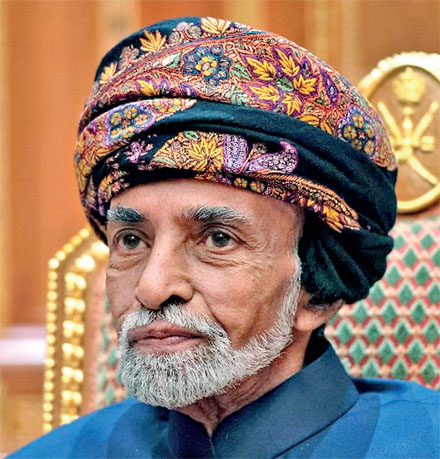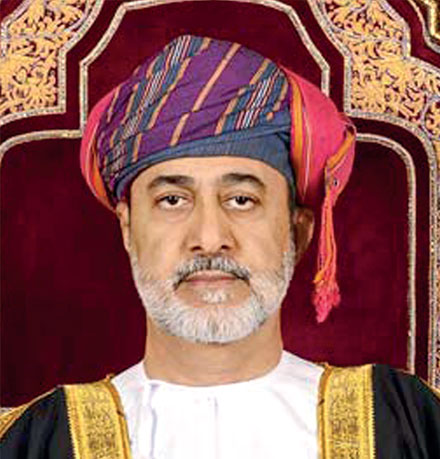Tuesday Apr 22, 2025
Tuesday Apr 22, 2025
Thursday, 18 November 2021 00:05 - - {{hitsCtrl.values.hits}}

Late Sultan Qaboos bin Said Al Said

Sultan Haitham bin Tariq
|
 Introduction
Introduction
The demise of the Sultan Qaboos Bin Saeed of the Sultanate of Oman in 2020 occurred at a toughest time in the history of the Sultanate of Oman. As might be expected, there was a heavy outpouring of grievance and paying tributes in every nook and corner of the country and in fact in the entire region. His loss was felt especially because of his wise leadership as well as his belief in peaceful dialogue in resolving regional disputes. He was an inspiration to the whole world due to his deeply rooted faith and the epitome of wisdom in peace, and his iconic steps in resolving disputes diplomatically.
Many experts proudly describe him as a legend who, over 50 years, transformed a developing country on the Arabian Peninsula into a modern state which continues to be diplomatically neutral in a turbulent region. This article aims to impart his legacy in the contemporary context and mark it as a tribute to his remarkable achievements in the modern Omani renaissance.
Early life and education
Sultan Qaboos bin Saeed was born in Salalah in Dhofar, the most southerly city on 18 November 1940. He was the son of the late Sultan Said Bin Taimur and the eighth direct descendent of the Al-Busaidi dynasty founded in 1744 by Imam Ahamed Bin Said. The Sultan spent his childhood in Salalah. When he reached the age of 16, he was admitted to a private school in England in 1960, and he entered the Royal Military Academy Sandhurst as an officer cadet.
Upon his graduation, he joined a British infantry battalion on operation in Germany for one year and held a staff appointment with the British Army. After his military services, he started to study local government subjects in England. Then, he returned home to Salalah where he was able to excel in the Islamic studies and history of Oman.
Soon after he acceded to the throne on 23 July 1970, Sultan Qaboos moved to Muscat to execute his country’s vision. Many political scientists describe Late Sultan Qaboos as a kind in the Arab world; he was unmarried, lived alone, played the lute, and composed music. He has left admirable legacies to his nation to uphold them to regain the glorious past the entire country proudly recalls.
The legacy of the late Sultan Qaboos
When he took the reins of the country, he made a promise to his people. It was a remarkable statement the country ever recorded. It said: “My people, I will proceed as quickly as possible to transform your life into a prosperous one with a bright future. Every one of you must play his part towards this goal. Our country in the past was famous and strong. If we work in unity and cooperation, we will regain the glorious past and take a respectable place in the world. I call upon you to continue living as usual.”
By the time of his accession to the throne, the country faced many internal and external challenges. Among them, the internal division, an acute economic crisis and consequent increase in poverty were significant. He had to embark on serious economic reforms to sustain internal stability and ensure his vision for the country. Besides, he had to uphold a neutral foreign policy amid polarising conflicts in the region. From the very beginning, Sultan Qaboos Bin Saeed mobilised the people’s energy towards the renaissance that he had dreamt of by unifying the Sultanate of Oman with a new flag. He called on fellow Omanis who had left the country to return to home to contribute to the expulsion of challenges that stand ahead of and use their potentialities to achieve pinnacles.
While profoundly appreciating the charismatic leadership of late Sultan Qaboos, we can conclude that his legacy was predominantly built on four pillars. First, he was instrumental for the blessed renaissance and emergence of the modern state. Secondly, he conceptualised his views on unique and pragmatic foreign policy, which survives in the MENA region. Thirdly, sustainable economic reform that he embarked on throughout his tenure. Finally, he firmly believed in pluralism and religious tolerance, which is the only way for mutual respect and coexistence. It helped Oman preserve its unique religious and cultural identities even today.
Renaissance and birth of modern state
In the modern history of Oman, the accession of the late Sultan Qaboos in 1970 completely altered the face of the country in a way people were amazed. Yes. It was a tremendous transformation that the people of Oman have witnessed. The plight of Oman before Sultan Qaboos took over the reins was too pathetic since the country had been fragmented and was largely dependent on British military might. Moreover, it had inherited instability, extreme poverty and a high level of illiteracy due to the restrictive and isolationist policies of previous rulers. Prior to the tenure of Sultan Qaboos, the entire country had only three public schools, two hospitals with minimal medical care and just about 10km of road. The life expectancy was around 50 years. Almost the country was devoid of modern infrastructure and amenities.
The accession of Sultan Qaboos on 23 July 1970 was no doubt a foundation for the golden era of the country in modern history. Sultan Qaboos overcame all the challenges and achieved the pinnacle with the spirit of true Omani tradition and unique identity. Apart from that, the late Sultan Qaboos used the country’s oil revenue to modernise the nation while preserving the country’s rooted culture and heritage, which cannot be commensurate with any other Arab nation.
The vivid testimonies of blessed renaissance and subsequent emergence of modern state, which were able to achieve through various decisive measures taken by Sultan Qaboos in the wake of his accession to the throne, are the milestones the country came across such as exit from isolationism, creation of Omani Nationalism and architecture of modern and moderate Oman.
Exit from isolationism and delegitimising Dhofar rebellion
When Sultan Qaboos came to power, the coast and the desert had been politically split. A separatist rebellion had broken out in Dhofar, in the Southwestern desert near new oil deposits. Qaboos’ foray into politics began favourably due to two factors that helped legitimise the Sultan. Primarily, Sultan Qaboos ended the restrictive policies and isolation and weakened popular hostility to Al Bu Said rule by touring the entire nation. He was then able to delegitimise the Dhofar rebellion in due course by systematic and gradual way.
Meanwhile, many political analysts praised Sultan Qaboos’ proactive and gradual measures in countering the rebellion. They went on to say that Sultan Qaboos had adopted three phases in the face of revolution. When Qaboos came to power in 1970, he offered a general amnesty to the Dhofari tribesmen and then sought their support for nation-building. Tribal guerrillas, who surrendered, were incorporated into the British-trained armed forces as well as governmental institutions. As a result, he was soon able to develop the desert interior economically.
Following the status quo in which rebellion was hijacked by Marxist radicals and subsequent transformation of the Dhofar rebellion into a war of ideology, the Sultan Qaboos initiated an ongoing campaign of consultations with friends and enemies to unite the country while having unleashed propaganda against their Marxist ideologies. Many describe this as classic counterinsurgency-cum-nation-building, and over time it worked. With weakened domestic support upon general amnesty, Dharfor rebellions began public execution and torture to prevent more defections. This act of persecution alienated those rebellions further, and the government propaganda machine widened the crack into a chasm. Sultan Qaboos reminded his fellow Omanis and convincingly painted Dhofar rebels as foreign and anti-Islamic using culture and ideology to undermine his opponent.
At the same time, Sultan Qaboos established the Sultan Arm Force (SAF) centres and basic amnesties in the South. This strategy drew the public’s attention and humanised the SAF as a force for good in Dhofar and throughout Oman. By 1975 the desert rebellion was over, and Oman was poised for development as a modern state. The non-violence strategies and public centric approach enabled late Sultan Qaboos to erode the rebellion and unite people under his leadership.
|
Creation of Omani nationalism
From the very beginning, Sultan Qaboos Bin Saeed was able to mobilise the people’s energy towards the renaissance that he had dreamt of by unifying the Sultanate of Oman with a new flag. For Sultan Qaboos to achieve his dream for the country, he had firmly believed in the countrymen and their active involvement. Once, he said: “Nations are built only with the hands of its citizens.” Hence, he had accumulated his all endeavours to unite the people at any cost as a part of his vision. Of course, the inclusive approach that Qaboos adopted was the essence that paved the way for creating a bond between people and the country. It is also worthy of mentioning that the foundation laid by Sultan Qaboos for the establishment of Omani Nationalism was inspired by the unique Omani traditions and cultural identities.
In his journey towards national unity, he had followed step by step process. Initially, he used the Southern Dhofar Rebellion (1962-1976) to catalyst paternalistic and Islamic Nationalism instead of the communist rebels. Then, he carefully connected highly influential triangular poles, namely Merchant community, tribalism, and Military SAF, to march forward and succeed in creating Omani Nationalism. His inclusive approach, particularly granting general amnesty and subsequent lifting of acute restrictions, ensured that everyone, including the South, could feel nationhood under Qaboos’ Oman, and it was symbolised by the nation’s name change from ‘Muscat and Oman’ to simply ‘the Sultanate of Oman’.
From 1970 to 1975, Omani Nationalism took a significant shape. Although modern Oman was united as an Islamic Sultanate against the Dhofar rebels, he had to restructure two powerful social and political classes that prevailed in Oman and then security apparatus in line with modern statehood. Primarily, he restructured Oman’s traditional power base, which had influenced the tribes and Merchant class. Many analysts say, perhaps due to cultural isolation and later oil discoveries, Oman was the last Gulf state to restructure the powerful tribal politics of its nation under the borders of a modern state.
As a part of his restructuring of the powerful socio-political framework, Sultan Qaboos addressed the political divisiveness of tribalism by incorporating the familiarity of the Majlis tradition into modern Oman’s political structure while retaining his role as head of state. Sultan Qaboos used Majlis as an instrument for creating synergy between traditional tribalism and the nation-state. And then, the Merchant class, another significant social class at that time, co-opted Sultan Qaboos due to their expertise in international trade and their subsequent transformation into technocrats for much needed administrative roles. Then, he focused on restructuring military and security forces into an influential political class.
The structural change through the amalgamation of triangular poles with the help of an inclusive approach enabled late Sultan Qaboos to succeed in creating strong Omani Nationalism at an early stage while cementing his role as a father of the modern nation and the progenitor of Oman’s Nationalism.
Craftsman of modern and moderate Oman
Another significant milestone that the country witnessed upon the ascendance of Sultan Qaboos to the throne was its transformation into a modern, stable and inclusive state after being a fragmented and poorest state. In the 1970s, Oman was isolated from much of the world and almost totally devoid of modern infrastructure and amenities where life expectancy was then around 50 years. Basic infrastructure such as paved roads, public schools and health care system were rare to see. Following the end of the country’s isolation, Sultan Qaboos used its oil revenue to modernise the nation while preserving its rich culture and fabulous heritage.
He ensured the creation of a better institutional framework, including a national constitution, a bicameral parliament, and various ministries to manage the effective functioning of a modern state. Besides, he took many efforts to transform an ethnically mixed and tribally diverse population into nationally cohesive citizens. At the same time, he advocated greater gender equality by introducing suffrage, appointing women to positions of power and creating employment opportunities for all. Similarly, he pledged to establish essential and sophisticated infrastructure facilities such as a wide network of roads and highways, hospitals, airports, bridges, dams, desalination plants, public utilities, schools, colleges, universities and telecommunication. It was estimated that life expectancy in Oman exceeded 77 years, and literacy is estimated at 96% of the adult population.
Such tremendous efforts increased the Sultanate’s profile on the world stage and gained appreciation from international communities and organisations. Besides, it led to the emergence of an educated middle class within a short period. Oman today has excellent infrastructure facilities, well-established institutions, many educational establishments for boys and girls from nursery to university degree. Many analysts describe Sultan Qaboos built modern and moderate Oman throughout his tenure with much patience.
Conclusion
In the four decades, late Sultan Qaboos had brought the country from the throes of anarchy and rebellion to being a solid and modern country with a minimum of repression. Generally speaking, he laid a strong foundation through his visionary leadership and consolidating his four pillars. However, the country faces many internal threats such as high unemployment, budget deficit, dwindling oil reserves, and lack of clear-cut solutions, along with external threats that predominantly advance foreign expansionist agenda. At this crucial stage, the choice of his cousin Haitham as his successor with his background in several port-polio and architecture of 2040 over Haitham’s brother Asad and Shihab – both military men – is a perfect move and appears to signal his desire to uphold economic reforms and also to perpetuate Oman’s role as a facilitator of regional diplomacy.
Under its new ruler, the Sultanate of Oman started to pursue its journey with renewed spirit, established dynamics, and sincere hope that people placed on their leader. We can learn through the legacies of legend Late Sultan Qaboos is none other than the faith in slow but steady growth. He urged an inclusive approach and the perfect understanding of its potentialities as a strategically important location in the Indian Ocean. He firmly believed in the importance of religious pluralism and tolerance in uniting people with different faiths to march forward and adopt modernity while preserving deeply seated tradition and culture.